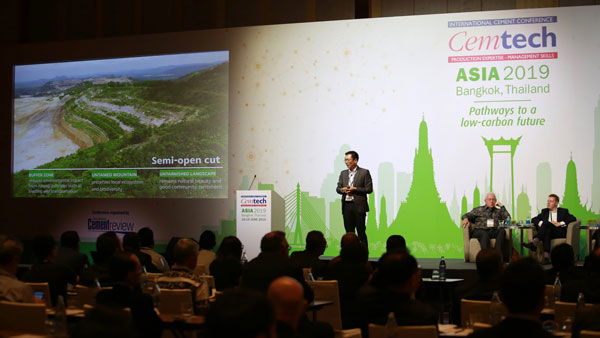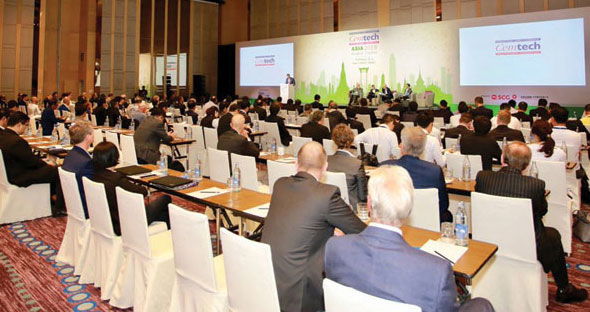Cemtech Asia 2019 has opened its doors to delegates from over 35 countries across the regional cement industry, which is being held at the Avani+ Riverside hotel, Bangkok, Thailand, between 16-19 June.

Cemtech Asia 2019 discusses pathways to a low-carbon future
Thomas Armstrong, managing director of International Cement Review, began the proceedings by welcoming delegates to Bangkok for this unmissable industry event. Mr Armstrong looked at the driving factors which have led to the necessity to discuss "Pathways to a low-carbon future", the conference title. With regulatory frameworks such as emissions trading schemes coming to the fore across the cement sector, it is important that Asia, a region which represents six per cent of global consumption, matches its high pace of capacity growth with corresponding strategies to reduce carbon emissions.
Conference highlights so far
In the first conference paper, Paul Roger of Exane BNP Paribas (UK) explored the demand and pricing scenario for global cement markets in the remainder of 2019 and 2020. Mr Roger noted that "demand has been very strong in Europe" in 2019, while mixed results were recorded across the emerging markets. "We expect good growth here in Asia to continue" said Mr Roger, referring to the rest of 2019, while also highlighting a surprising four per cent rise in YTD demand in China. In relation to the title of this year's conference, he stated that the EU Emissions Trading Scheme (ETS) could result in a major shakeup, particularly amongst smaller producers, in Europe.

Delegates from more than 35 countries currently attend Cemtech Asia 2019, the region's key cement industry conference
Martin Wilkes (Indonesia) continued by delivering an additional contribution to the event's extensive coverage of regional cement markets. Mr Wilkes considered how the cement industry in the ASEAN countries has grown and developed over the past 20 years. Recent notable developments include the "LafargeHolcim ASEAN blackout". Before the Lafarge and Holcim merger, both companies had a combined 60Mta of capacity in the ASEAN region, however the company is soon expected to have no operational manufacturing capacity in the region after selling assets in Indonesia, Malaysia, Singapore and an awaited sale in the Philippines.
SCG Cement's keynote speaker, Wachirachai Koonamwattana (Thailand), concluded the opening session of the conference by examining the global circular economy and how this model can be applied to the cement industry to assist resource management in Asia. The company operates sustainable mining practises via a semi-open cut mine to reduce the environmental impact and enable zero-waste mining. As part of the programme, delegates will have the opportunity to visit SCG Cement's operations in Kaeng Khoi, Saraburi province, to see these sustainable mining practices in action.
Moving into technological and process developments, Laurent Grimmeissen of Cementis (Switzerland) introduced LC3, limestone calcined clay, blended cement to participants. The product allows the production of cement with as little as 50% clinker content at a comparable compressive strength to CEM I/OPC, while achieving a 35-40 per cent reduction in CO2 emissions.
Chip Mong Insee Cement Corp's Aidan Lynam (Cambodia) highlighted the successful start up of its new 5400tpd plant. Located in a super high-growth market near the capital, Phnom Penh, the plant is already sold out of product. Future sustainability plans for the company include reducing CO2 emissions to 675kg/t of cement from 776kg/t by 2022, while also becoming net water positive in the same period. The company is also expected to soon move into the bulk cement market.

Peter Hoddinott discusses the key role of
government in creating demand
Since it is an issue that is still of significant importance to the industry, Peter Hoddinott (Indonesia) revisited his presentation delivered in Cemtech Asia 2018 and looked at additional ways to survive in an oversupplied market. Mr Hoddinott looked at the key role of the government in creating demand through essential infrastructure projects alongside affordable housing programmes and concrete roads.
Outside of the conference programme, delegates have had the opportunity to directly interact with world-class equipment providers in the sold-out exhibition.
The event will run until Wednesday, 19 June and conclude with a field trip to SCG Cement's Kaeng Khoi operations.
